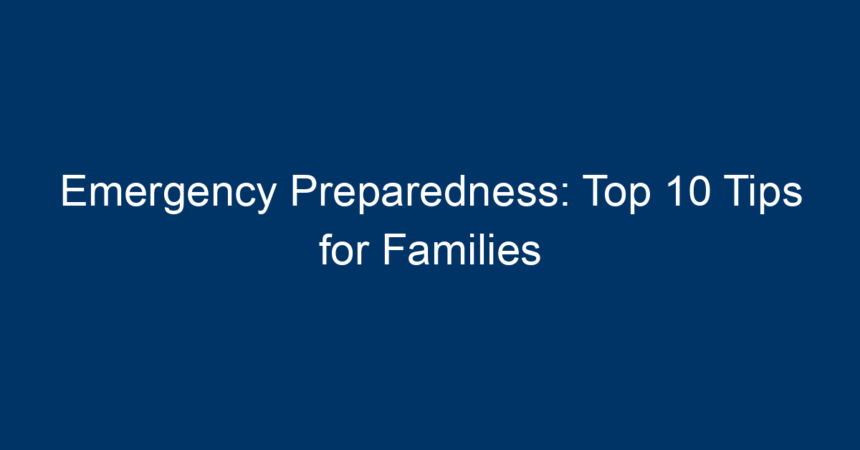In today’s ever-changing world, being prepared for unexpected events is not just wise; it’s essential. Whether it’s a natural disaster, a sudden illness, or even social unrest, families need to equip themselves with the knowledge and tools necessary to handle emergencies effectively. Emergency preparedness ensures that you and your loved ones can navigate crises with minimal stress and maximum safety. In this article, we’ll provide you with the top 10 tips to enhance your family’s emergency preparedness.
1. Create an Emergency Plan
The Importance of an Emergency Plan
Every family should have a comprehensive emergency plan in place. This acts as your roadmap during a crisis, ensuring everyone knows what to do and where to go.
Key Components of Your Plan
- Contact List: Compile essential phone numbers, including relatives, family friends, and emergency services.
- Meeting Points: Designate both local and distant meeting spots in case of evacuation.
- Roles and Responsibilities: Assign specific tasks to each family member, ensuring everyone knows their role.
2. Build an Emergency Kit
Essentials for Every Family Kit
A well-stocked emergency kit is vital for immediate survival. Here’s what to include for effective emergency preparedness:
- Water: At least one gallon per person per day for three days.
- Non-perishable Food: Enough to last for at least three days.
- First-Aid Supplies: Bandages, antiseptics, and over-the-counter medications.
- Flashlights and Batteries: Ensure all devices are functional.
- Multi-tool/Knife: Useful for a variety of situations.
Maintenance of Your Kit
Regularly check your emergency kit to replace expired items and ensure everything is in good working condition.
3. Stay Informed About Risks
Local Hazards
Understanding the specific risks faced by your locality is a critical step in your emergency preparedness plan. This might include:
- Natural disasters (hurricanes, earthquakes, floods)
- Industrial accidents
- Health crises
Resources for Information
Utilize local government websites, community bulletins, and weather updates to stay informed about potential risks. Subscribe to emergency alerts to receive timely updates.
4. Practice Regular Drills
The Importance of Drills
Practicing what to do in an emergency ensures that everyone knows their roles and can act swiftly.
Types of Drills
- Fire Evacuation: Conduct a fire drill to practice how to exit your home safely and quickly.
- Earthquake Drills: Teach everyone to “Drop, Cover, and Hold On.”
- Communication Drill: Practice using your emergency contact list and meeting points.
5. Secure Your Home
Home Safety Measures
Safety in your home can mitigate risks during emergencies. Here’s how to secure your space:
- Reinforce Windows and Doors: Install secure locks and consider shutters or reinforced glass.
- Protective Landscaping: Trim trees that could fall on your home during a storm.
- Emergency Exits: Ensure all exits are accessible and free from obstruction.
Fire Safety Equipment
Equip your home with smoke detectors and fire extinguishers. Test alarms monthly and replace batteries at least once a year.
6. Involve Everyone in the Process
Family Engagement in Emergency Preparedness
Include every family member in planning and preparation activities to instill confidence and knowledge.
Teaching Kids
Teach children about the dangers they could face and involve them in creating the emergency kit. This instills a sense of responsibility and familiarity with emergency protocols.
7. Plan for Your Pets
Consider Your Furry Family Members
Don’t forget your pets in your emergency preparedness plans. They are part of your family and need protection too.
Essential Pet Supplies
- Food and Water: Ensure you have enough supplies for your pets.
- First-Aid Kit: Include pet-specific medications and supplies.
- ID Tags and Microchip: Ensure pets have identification for easy retrieval if they get lost.
8. Financial Preparedness
Emergency Funds
Financial readiness is a crucial, yet often overlooked, aspect of emergency preparedness.
- Savings for Emergencies: Set aside funds specifically for emergencies, making it easier to handle unexpected expenses.
- Important Documents: Store essential documents like insurance policies, identification, and medical records in a waterproof container.
Digital Solutions
Consider keeping digital copies of important documents in cloud storage for easy access when needed.
9. Stay Connected
Communication Plans
During an emergency, communication can become chaotic; having a plan will keep your family connected.
- Group Chats: Create a family group chat for quick communication.
- Emergency Phones: Have a list of borrowed or off-grid communication options available.
Community Involvement
Engage in community emergency preparedness programs. Connect with neighbors and plan group responses to local hazards, strengthening community bonds.
10. Continuous Learning and Adaptability
Stay Updated on Best Practices
Emergency preparedness is not a one-time task. Stay informed about the latest in disaster management and emergency preparedness strategies.
- Workshops and Courses: Attend local workshops to learn about first aid, CPR, and disaster response.
- Review and Revise: Periodically revisit your emergency plan and kit, making necessary updates.
Conclusion: Taking Action on Emergency Preparedness
Emergency preparedness is an ongoing process that requires commitment from every family member. By implementing these 10 tips, you can create a safer, more resilient environment for yourself and your loved ones. Remember that the key to surviving any emergency lies in planning, practice, and staying informed.
Take the time today to develop your emergency plan, build your kit, and engage your family in preparedness discussions. The safety and security of your family depend on your proactive measures to be ready for whatever life may throw your way. By prioritizing emergency preparedness, you’re not just protecting your family; you’re ensuring peace of mind. So start planning today for a safer tomorrow!




